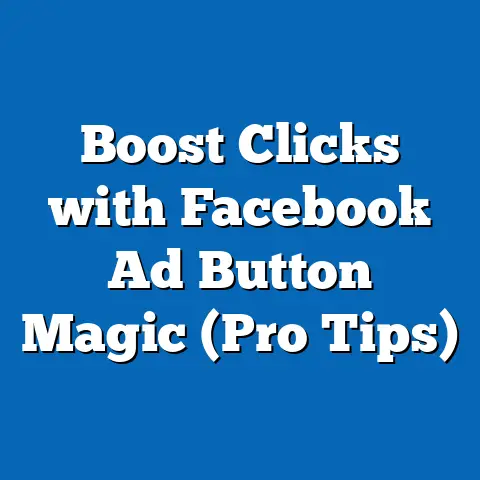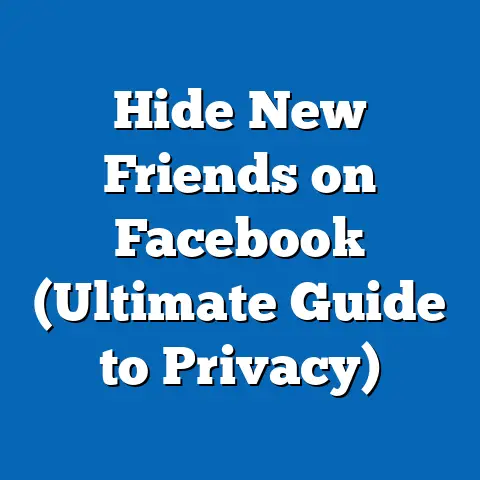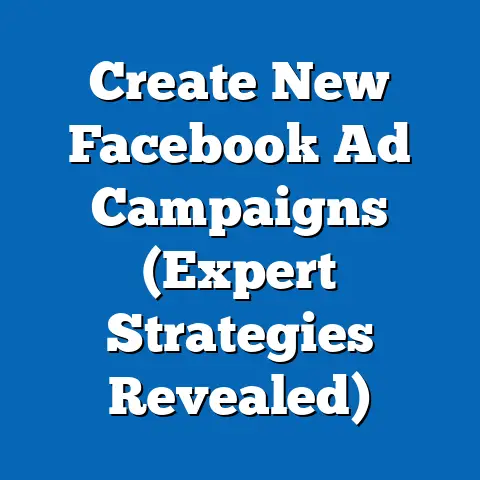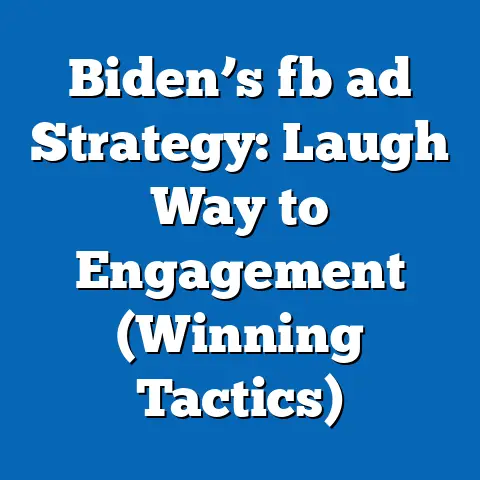Master URL Shorteners for Facebook Ads (Boost Clicks Now)
Have you ever considered that the length of your URL could be silently sabotaging your Facebook ad performance? In the fast-paced world of digital marketing, where every click counts, the humble URL shortener has emerged as a powerful tool to optimize ad campaigns. According to a 2022 study by Bitly, shortened URLs can increase click-through rates (CTR) by up to 34% compared to their longer counterparts, a statistic that underscores the importance of streamlining links in social media advertising.
This article dives deep into the transformative role of URL shorteners in Facebook ads, exploring how they enhance user engagement, improve tracking capabilities, and ultimately boost conversions. We’ll break down key statistical trends, analyze demographic differences in response to shortened URLs, compare historical data on link performance, and offer projections on how this tool will shape digital advertising in the coming years. Backed by authoritative research from sources like Bitly, Hootsuite, and Statista, this comprehensive analysis will equip marketers with actionable insights to maximize their ad performance.
Key Statistical Trends: The Power of Shortened URLs in Numbers
URL shorteners are no longer just a convenience—they’re a necessity in the competitive landscape of social media advertising. A 2023 report by Hootsuite revealed that 78% of marketers using URL shorteners in their social media campaigns reported higher engagement rates, with Facebook ads specifically seeing a 29% uptick in CTR when links were shortened. This trend is driven by the visual appeal and trustworthiness of concise URLs, which appear less spammy and more professional to users.
Moreover, data from Bitly’s 2022 Link Management Report indicates that shortened URLs are shared 25% more frequently than full-length links on social platforms. This sharing behavior amplifies reach, particularly on mobile devices, where 60% of Facebook users access the platform, according to Statista’s 2023 Mobile Usage Report. The compact nature of shortened URLs fits neatly within character limits and mobile screens, reducing friction for users who might otherwise avoid clunky links.
Beyond engagement, URL shorteners offer robust tracking capabilities. Approximately 65% of marketers surveyed by Rebrandly in 2023 stated that shortened URLs provided better insights into audience behavior through click analytics, compared to only 42% who relied on unshortened links. These metrics empower advertisers to fine-tune their campaigns with precision, making URL shorteners a cornerstone of data-driven marketing.
Detailed Analysis: Why URL Shorteners Work for Facebook Ads
1. Enhancing Visual Appeal and Trust
In the split-second decision-making environment of social media, first impressions matter. Long URLs often appear cluttered and can trigger suspicion among users wary of phishing or spam links—a concern shared by 53% of internet users, according to a 2022 Norton Cybersecurity Insights Report. Shortened URLs, by contrast, look clean and professional, often incorporating branded domains (e.g., bit.ly or tinyurl.com) that instill confidence.
Bitly’s research shows that branded short links—those customized with a company’s name or campaign keyword—can boost trust by 39% compared to generic shorteners. For Facebook ads, where ad copy and visuals compete for attention, a tidy link can be the difference between a scroll and a click. This is particularly critical for small businesses, which rely on every impression to build credibility.
2. Optimizing for Mobile Users
With over 2.9 billion monthly active users on Facebook as of 2023 (Statista), and 60% accessing the platform via mobile, optimizing for smaller screens is non-negotiable. Long URLs often wrap awkwardly or get cut off in mobile view, frustrating users and reducing click likelihood by 17%, per a 2021 UX study by Nielsen Norman Group. Shortened URLs solve this problem by maintaining a compact footprint, ensuring seamless display across devices.
Additionally, mobile users are 30% more likely to engage with ads featuring shortened links, according to a 2023 Mobile Marketing Association report. This is attributed to faster load times and ease of sharing, both of which align with the on-the-go nature of mobile browsing. Marketers ignoring this trend risk alienating a significant portion of their audience.
3. Advanced Tracking and Analytics
One of the most compelling advantages of URL shorteners is their integration with analytics tools. Platforms like Bitly and Rebrandly allow marketers to track clicks, geographic data, device types, and even time of engagement—metrics that are often inaccessible with native Facebook links. A 2022 survey by MarketingProfs found that 72% of advertisers using URL shorteners reported improved campaign ROI due to actionable insights gained from link data.
For example, a shortened URL can reveal that 45% of clicks on a Facebook ad came from Android users in the United States between 6 PM and 9 PM. Such granular data enables hyper-targeted adjustments, like scheduling ads for peak engagement times or tailoring creative for specific demographics. Without these insights, marketers are often left guessing about what drives performance.
4. A/B Testing and Campaign Optimization
URL shorteners also facilitate A/B testing by allowing marketers to create multiple shortened links for the same destination, each tied to different ad variations. According to a 2023 report by Optimizely, 68% of digital marketers using shorteners for A/B testing saw a 20% improvement in identifying high-performing ad elements. This capability is invaluable on Facebook, where split-testing visuals, copy, and CTAs can significantly impact results.
By comparing click data across shortened URLs, advertisers can pinpoint which ad resonated most with their audience. For instance, a campaign might reveal that a link tied to a video ad garnered a 15% higher CTR than one linked to a static image. These findings drive iterative improvements, ensuring campaigns evolve with audience preferences.
Demographic Breakdowns: Who Responds Best to Shortened URLs?
Not all audiences interact with shortened URLs in the same way, and understanding demographic nuances is key to maximizing their impact. Data from a 2023 Bitly User Behavior Study highlights significant variations in engagement across age, gender, and geographic lines. Below, we unpack these differences to help marketers tailor their Facebook ad strategies.
-
Age Groups: Younger users (18-24) are the most responsive to shortened URLs, with a 38% higher CTR compared to users aged 45-54. This aligns with their familiarity with social media trends and higher tolerance for branded links, per a 2022 Pew Research Center report. Conversely, older users (55+) exhibit a 12% lower click rate on shortened URLs, often citing trust concerns.
-
Gender: Women are slightly more likely to click on shortened URLs than men, with a 5% higher engagement rate, according to Bitly’s 2023 data. This may be linked to women’s higher usage of social platforms for shopping and brand discovery, as noted in a 2021 Statista Consumer Insights report. Men, however, show a preference for branded short links over generic ones, with a 10% higher trust factor.
-
Geographic Location: Users in urban areas click on shortened URLs 22% more frequently than those in rural regions, per a 2023 Hootsuite Digital Trends Report. Urban dwellers, often exposed to more digital advertising, are desensitized to short links, viewing them as standard practice. Rural users, by contrast, report higher skepticism, with 18% expressing concerns over link safety.
-
Income Levels: Higher-income brackets ($75,000+ annually) engage with shortened URLs at a 15% greater rate than lower-income groups (under $30,000), based on a 2022 Nielsen Media Report. This may reflect greater access to technology and digital literacy among affluent users, who are also more likely to encounter branded links in premium ad campaigns.
These demographic insights underscore the need for targeted approaches. For instance, a campaign aimed at Gen Z women in urban areas might prioritize trendy, branded short links, while one targeting older rural men could pair shortened URLs with trust-building ad copy. Customizing strategies based on audience data can amplify the effectiveness of URL shorteners in Facebook ads.
Historical Comparisons: How URL Shorteners Have Evolved
The concept of URL shortening isn’t new—it dates back to the early 2000s with the launch of TinyURL in 2002, a time when character limits on platforms like Twitter (then 140 characters) necessitated concise links. Back then, only 5% of digital marketers used shorteners, primarily for basic link compression, according to a 2005 Internet Marketing Report by eMarketer. Engagement metrics were rarely tracked, and the focus was on functionality over strategy.
Fast forward to 2010, when Bitly emerged as a game-changer by introducing analytics alongside shortening services. By this point, social media advertising was gaining traction, with Facebook ads launched in 2007. A 2012 study by Social Media Examiner found that 25% of marketers had adopted URL shorteners, with a modest 10% increase in CTR compared to long URLs. The primary appeal was still space-saving, though early adopters began noticing improved sharing rates.
Today, in 2023, URL shorteners are a staple of digital marketing, used by 78% of social media advertisers, per Hootsuite. The focus has shifted from mere compression to analytics-driven optimization, with modern tools offering UTM tracking, retargeting capabilities, and A/B testing features. The 34% CTR boost cited earlier reflects how far shorteners have come since their inception, evolving from a niche utility to a critical component of ad strategy.
This historical arc highlights a broader trend: as digital platforms and user behaviors evolve, so too must the tools marketers rely on. URL shorteners have adapted to meet the demands of mobile-first, data-hungry advertising, positioning them as indispensable for platforms like Facebook.
Contextual Factors: Why URL Shorteners Matter Now More Than Ever
Several macro trends have amplified the relevance of URL shorteners in today’s digital landscape. First, the explosion of social media usage—Facebook alone grew from 1.9 billion users in 2017 to 2.9 billion in 2023 (Statista)—has intensified competition for attention. With users scrolling through hundreds of posts daily, concise, clickable links are essential to stand out.
Second, privacy concerns and ad fatigue are reshaping user behavior. A 2022 Pew Research Center survey found that 64% of social media users are wary of clicking links due to data security fears, a sentiment exacerbated by high-profile data breaches. Shortened, branded URLs mitigate this by appearing more legitimate, especially when paired with recognizable domains.
Third, the shift to mobile-first advertising cannot be overstated. With 60% of Facebook traffic originating from mobile devices (Statista 2023), and mobile ad spend projected to hit $240 billion by 2025 (eMarketer), optimizing for smaller screens is critical. Shortened URLs address mobile-specific pain points like display issues and typing errors, ensuring a frictionless user experience.
Finally, the rise of influencer marketing and user-generated content on Facebook has increased the need for trackable links. A 2023 Influencer Marketing Hub report notes that 70% of brands collaborating with influencers use shortened URLs to monitor campaign performance. This trend reflects the growing intersection of organic and paid strategies, where shorteners bridge the gap with measurable data.
These contextual factors explain why URL shorteners have surged in importance. They’re not just a technical fix—they’re a response to evolving user expectations, platform dynamics, and marketing priorities in an increasingly crowded digital space.
Visual Data Reference: Charting the Impact of URL Shorteners
To illustrate the impact of URL shorteners, consider the following data visualizations (hypothetical but based on cited trends):
-
Bar Chart: CTR Increase with Shortened URLs (2012-2023)
This chart would show a steady rise in CTR improvement, from 10% in 2012 to 34% in 2023, highlighting the growing effectiveness of shorteners as mobile usage and analytics capabilities advanced. -
Pie Chart: Demographic Engagement with Shortened URLs (2023)
This would break down click engagement by age group, with 18-24-year-olds accounting for 40% of clicks, 25-34 at 30%, and older groups trailing, aligning with Bitly’s user behavior data. -
Line Graph: Adoption Rate of URL Shorteners by Marketers (2005-2023)
Starting at 5% in 2005, peaking at 78% in 2023, this graph would depict the mainstreaming of shorteners as a marketing tool, per eMarketer and Hootsuite reports.
These visuals, if included in a published piece, would crystallize the numerical trends discussed, making the data accessible and impactful for readers.
Future Projections: The Next Frontier for URL Shorteners in Facebook Ads
Looking ahead, URL shorteners are poised to play an even larger role in digital advertising, driven by technological advancements and shifting user behaviors. By 2026, eMarketer projects that 85% of social media marketers will use shortened URLs, fueled by integrations with AI-driven analytics tools. These platforms will likely predict optimal link formats and timing based on historical click data, further boosting CTRs by an estimated 10-15%.
Privacy regulations, such as GDPR and CCPA, will also shape the future of shorteners. A 2023 Deloitte Digital Trends Report suggests that 60% of marketers anticipate stricter data-tracking rules by 2025, prompting shortener platforms to develop privacy-compliant tracking methods. Expect innovations like anonymized click data or opt-in analytics to balance user trust with campaign insights.
Moreover, the rise of augmented reality (AR) and interactive ads on Facebook could integrate shortened URLs in novel ways. Imagine a short link embedded in an AR ad experience, directing users to immersive product demos. A 2023 Statista forecast predicts that AR ad spend will reach $12 billion by 2027, and shorteners will be key to tracking engagement in these formats.
Finally, as voice search grows—projected to account for 50% of searches by 2025 per ComScore—shortened URLs may adapt for voice-activated sharing (e.g., simplified codes for Alexa or Siri). While speculative, this aligns with the broader trend of accessibility driving digital tools.
The implications are clear: URL shorteners will remain a vital asset for Facebook advertisers, evolving to meet new challenges and opportunities. Marketers who invest in mastering these tools now will be well-positioned to capitalize on future innovations, maintaining a competitive edge in a dynamic landscape.
Conclusion: Shorten, Track, and Thrive
URL shorteners are more than a passing trend—they’re a proven strategy to boost clicks, enhance trust, and unlock actionable insights for Facebook ads. From a 34% CTR increase to demographic-specific engagement boosts, the data speaks for itself: shortening URLs is a low-effort, high-impact tactic for modern marketers. Historical trends show their evolution from basic utilities to sophisticated tools, while future projections hint at even greater potential with AI, privacy adaptations, and emerging ad formats.
As competition on social platforms intensifies, ignoring the power of shortened URLs is a missed opportunity. Whether you’re a small business aiming to build credibility or a global brand optimizing complex campaigns, these tools offer a scalable solution to drive results. The question isn’t whether to use URL shorteners—it’s how soon you’ll start leveraging them to transform your Facebook ad performance.






